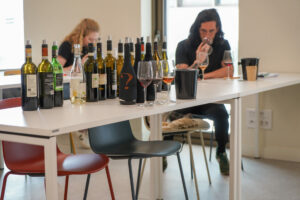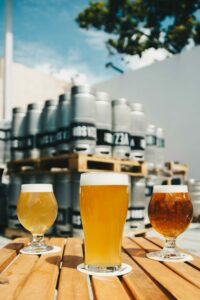The origin of absinthe is like Absinthe itself: quite unclear. The name absinthe seems to come from its main ingredient “grand wormwood (artemisia absinthium)”. We found out that it was originally consumed solely as medicinal tonic with traces of wormwood being used circa 1550 BC in Egypt. Later on, we found evidence of wines infused with wormwood by Hippocrate during the Greek civilization.
Modern days of absinthe emerged around the French Revolution (1789). First commercial purpose was realised by a businessman Major Dubied who opened a distillery in Couvet, Switzerland, followed by Henri-Louis Pernod, his son-in-law who opened a second one in Pontarlier France in 1805.
Popularity grew in the 19th century pushed by artists and upper-class who embraced the drink as a pre-dinner drink known as “Green Hour”. The fame was also aided by the phylloxera epidemic that ravaged France’s vineyards as wine wasn’t available anymore, people turned to absinthe as a substitute.
Wine lobby in alliance with the Temperance Movement pushed the French government to ban Absinthe, finally outcast in 1915.
Revival began in 1992 in Prague, where a blend of essential oils mixed with alcohol was sold as absinth. An Englishman spotted a business opportunity and brought it to the UK where absinthe have never been banned. Thanks to European Union regulation – if something is legal for one member country then it’s automatically legal for them all. The French government repealed the 1915 law in 2011.
The absinthe is traditionally made throughout four steps processed describe in the following:
Maceration
Distillation
Second maceration
Dilution
Bottling
Elaboration of Absinthe
Raw material
Like gin, absinthe is basically a flavoured vodka. Also like gin, the botanicals can be redistilled or made by cold compounding. The two key ingredients are Wormwood & Anise. Nevertheless, the only country to have a legal definition for absinthe is Switzerland. Any producer from elsewhere can use any botanical they want to make absinthe. The wormwood is harvested around July and hung to dry for two weeks before being sent to the distillery.
Anise contains a molecule called anethol responsible for the phenomena of colour change when adding water to absinthe. The molecule doesn’t mix with water causing haziness called: Louching.
Originally absinthe was first redistilled from grape spirit as it was the most alcohol available in this area (it has been created around the French Revolution). As European vineyards were devastated, producers switched to molasses, grain, sugar beet raw material to re-distil absinthe.
Maceration of absinthe
Once botanicals are delivered to the distillery, they are placed into copper alembic with alcohol for maceration for 12 to 36 hours. Certain producers prefer infusing the botanicals separately into alcohol and blend everything up to distillation later on. Some use a combination of both techniques.
Distillation of absinthe
Following the maceration process, the alembic is turned on to distil the macerated spirit. Once the temperature reaches 80°C, the vapour rises and is liquified back into a condenser to be collected. The first liquid coming out of the still is put away and known as the heads. The tails – the last couple litres coming out to the end – are removed as they contain heavy metals not desirable.
The absinthe from Switzerland called white absinthe must be sold after this process no post distillation maceration is allowed to be called as such.
Second Maceration of absinthe
Some other countries, particularly the French, take the heart of the distillation to another maceration step adding: petite wormwood, hyssop, melissa and other plants such as saffron, mint, parsley, etc. No artificial colourings are added during the traditional absinthe production. The colour is coming from the chlorophyll contained in some botanicals, used in the second maceration to give its iconic green colour.
Dilution and bottling of absinthe
After maceration, the spirit is filtered to remove the botanicals and diluted to be bottled, typically at high strength.
Cold compounding
Like gin some absinthes are made with cold compounding technique. The technique consists of adding artificial colours and flavourings to alcohol to be later sold as absinthe. These spirits are lacking true botanical complexity and, as not made with true botanicals, they do not louche.
Would you like to learn more about absinthe and other spirits? Discover the WSET courses from levels 1 to 3 in spirits offered by WiSP by clicking here.








